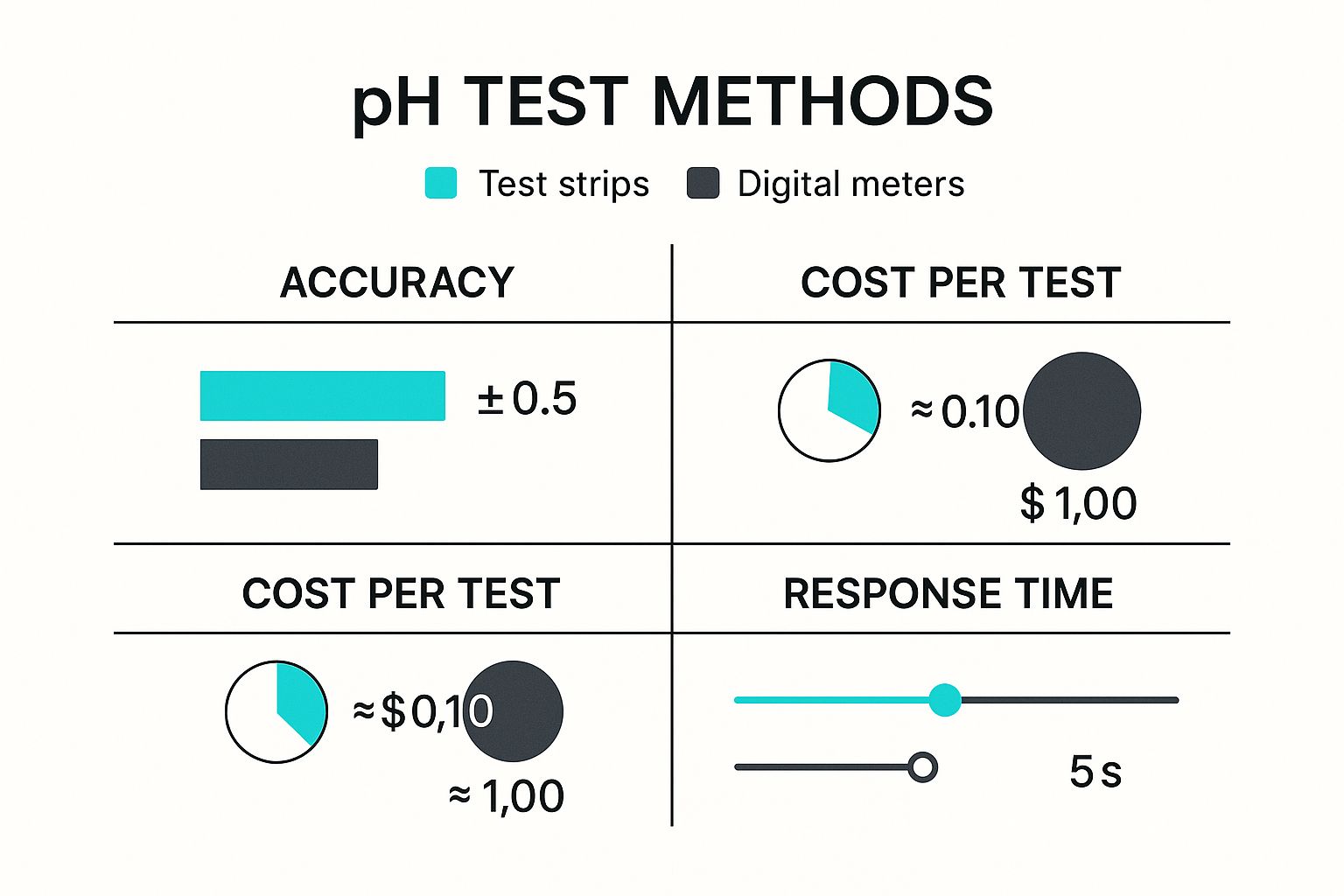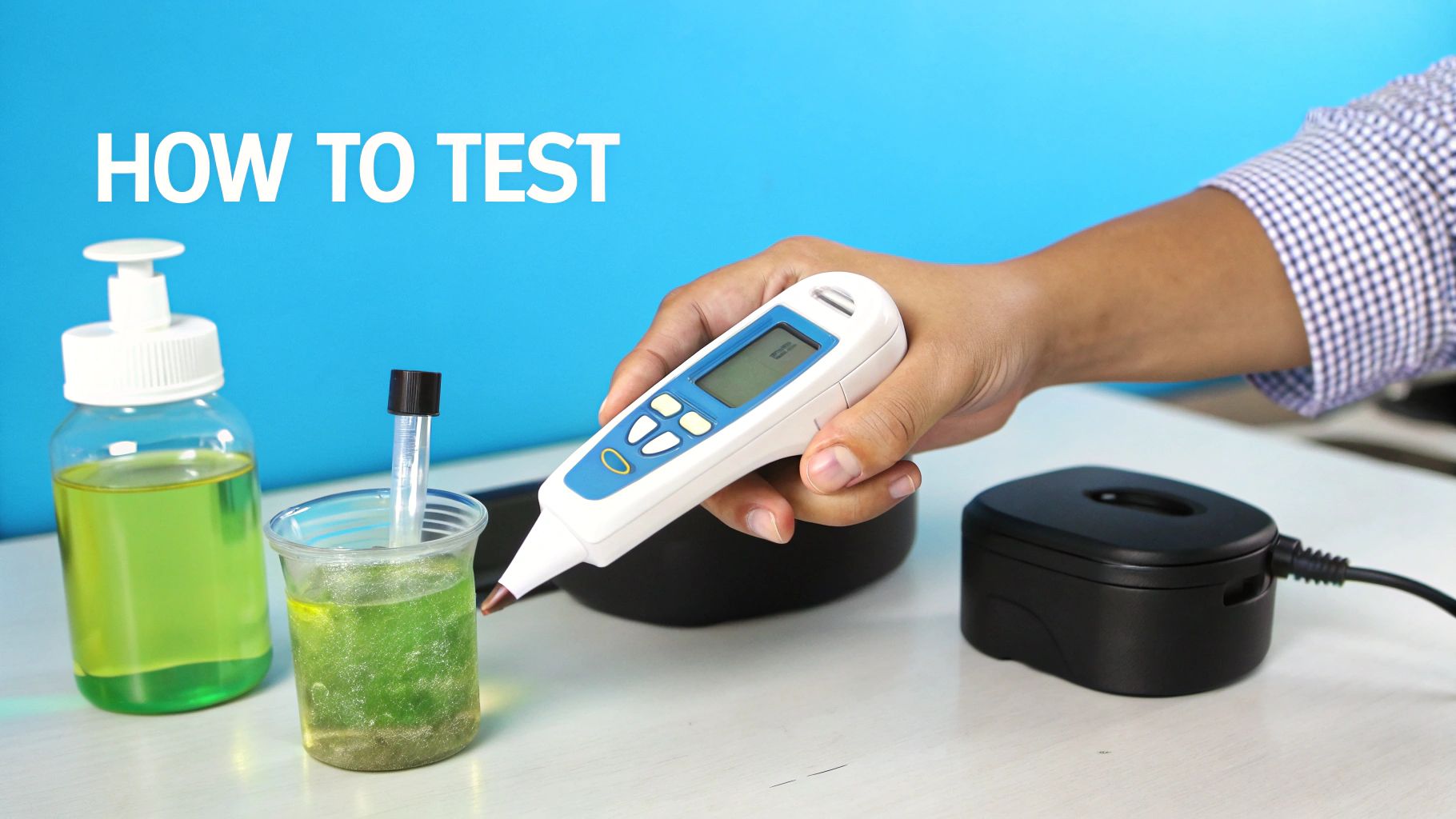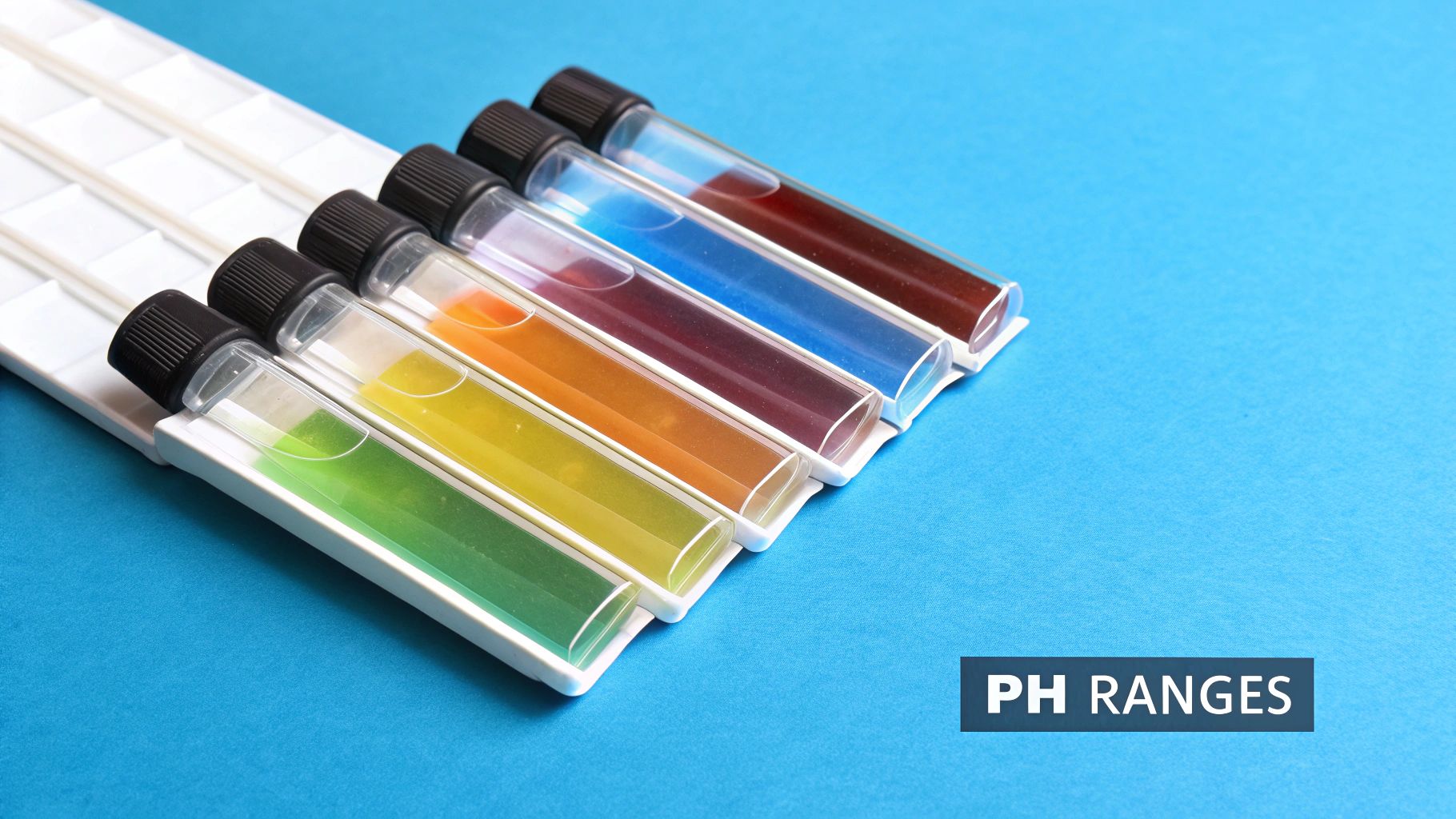For a koi pond, pH is like the very air we breathe: essential, invisible, and utterly life-sustaining. A stable pH level is the bedrock of a healthy pond, but when it starts to swing, it puts immense stress on your fish. That's why reliable pH water testers are non-negotiable for monitoring this vital parameter and protecting your prized koi.
Why Perfect pH is Crucial for Your Koi Pond
Imagine living in a house where the oxygen level constantly changes without warning. One moment it's fine, the next you're struggling to breathe. This is what an unstable pH feels like for your koi. It’s an invisible stressor that directly impacts their health, immunity, and overall vibrancy.

When pH levels swing too far, it can lead to severe health problems. Even small, rapid shifts can cause gill damage, slash their ability to fight off common parasites, and compromise their slime coat—their primary line of defence against infection. Maintaining a stable environment isn't just a goal; it's a necessity.
Understanding the pH Scale
At its heart, the pH scale measures how acidic or alkaline your pond water is, running from 0 to 14. A pH of 7.0 is neutral. Anything below that is acidic, and anything above is alkaline. For koi, the sweet spot is a stable range between 7.0 and 8.5.
The secret to koi health isn't chasing a single "perfect" number. It's about preventing rapid fluctuations. A pond that consistently holds a pH of 8.2 is far healthier than one that bounces wildly between 7.0 and 8.5 every day.
This focus on stability is why consistent monitoring with a good pH tester is so critical. Without accurate data, you’re flying blind.
The Role of Regular Testing
Regular testing helps you understand your pond's natural rhythm and catch potential disasters before they harm your fish. It empowers you to:
- Prevent Health Crises: Spot and correct dangerous pH swings before they cause stress or illness.
- Ensure Treatment Effectiveness: Many water treatments and medications work best within a specific pH range. If your pH is off, your treatments might be useless.
- Maintain a Stable Ecosystem: Consistent pH supports the beneficial bacteria in your filter, which are essential for breaking down fish waste.
Ultimately, using a pH water tester moves you from being a reactive pond keeper to a proactive one. It gives you the power to create the stable environment your koi need to thrive, which is also a vital part of managing routine tasks like how to plan your koi pond water changes effectively.
Choosing Your Weapon: A Comparison of pH Tester Types
When it comes to keeping your pond healthy, picking the right tool is your first move. The world of pH water testers boils down to three main types, each with its own pros and cons. Your decision will likely depend on your budget, time, and the level of precision you need.
Let's break down the three main contenders so you can figure out which one fits your routine and your koi's needs.
Quick and Convenient: Test Strips
For pond keepers who just need a quick health check, test strips are the go-to. These are small strips with chemical pads that change colour when dipped into a water sample. Just dip, wait a moment, and match the colours to the chart on the container.
Their biggest advantage is convenience. There’s no mixing or measuring. However, you trade precision for ease of use. Test strips are fantastic for catching major pH swings, but they can be tricky to read for subtle changes.
The Balanced Approach: Liquid Test Kits
Liquid test kits offer a solid step up in accuracy from strips without the price tag of a digital meter. With these kits, you add reagent drops to a small vial of your pond water. The water changes colour, and you compare that hue against a more detailed colour chart.
While they take more effort than strips, the results are generally more reliable and easier to read with confidence. For a deeper dive into the different kits out there, check out our guide to the best water testing kits for ponds. This method is perfect for the hobbyist who wants dependable data without breaking the bank.
The Gold Standard: Digital pH Meters
If you want the highest possible degree of accuracy, nothing comes close to a digital pH meter. These electronic gadgets use a sensitive electrode to give you a precise numerical reading, often down to one or two decimal places. This removes any need for colour-matching or interpretation, giving you an exact number in seconds.
A digital meter removes all ambiguity. You're no longer guessing if the colour is closer to 7.4 or 7.6—you get a definitive number, which is crucial for tracking small but significant trends in your pond's chemistry.
To help you decide, here’s a quick comparison of the three main types of pH testers.
pH Water Tester Comparison Guide
| Tester Type | Accuracy Level | Average Cost | Ease of Use | Best For |
|---|---|---|---|---|
| Test Strips | Low | £ | Very Easy | Quick, daily spot-checks and beginners. |
| Liquid Kits | Medium | ££ | Moderate | Hobbyists wanting reliable data on a budget. |
| Digital Meters | High | £££ | Easy (with calibration) | Serious keepers who need ultimate precision. |
Each type has its place in a pond keeper's toolkit. Your choice depends on whether you prioritise speed, accuracy, or cost.
The image below gives a visual breakdown of the trade-offs between the convenience of test strips and the precision of digital meters.

While digital meters require a higher initial investment and maintenance like calibration, their incredible accuracy (±0.1) and speed make them an invaluable tool for any serious koi keeper.
Mastering Your Digital pH Meter
For the serious koi keeper, nothing beats the precision of a digital pH meter. While they might look technical, getting the hang of these devices is quite simple. A little care and proper calibration is all it takes to get accurate, trustworthy readings every time.

The heart of your digital meter is the electrode – the sensitive glass bulb at the tip. This part is incredibly important and must always be kept moist in a special storage solution. If you let it dry out, you risk permanent damage, leading to faulty readings.
The Calibration Process Explained
Think of calibration like tuning a guitar. It ensures your meter is aligned with known standards so the readings are spot on. You’ll want to calibrate your pH water tester out of the box, when you change the batteries, and at least once a month to keep it sharp.
The process is straightforward and uses buffer solutions, which are liquids with a stable, known pH value.
- Start with Neutral: First, rinse the electrode with distilled water and gently dab it dry. Pop the electrode into the pH 7.0 buffer solution and wait for the number on the screen to settle.
- Lock in the Reading: Press the "calibrate" button on your meter. The device will recognise the pH 7.0 solution and lock that in as its neutral starting point.
- Calibrate the Second Point: Rinse the electrode again and place it into either the pH 4.0 or pH 10.0 buffer solution. Once the reading is stable, press the calibrate button again to confirm.
That’s it. This two-point calibration gives the meter a reliable frame of reference, ensuring it reads accurately.
Taking an Accurate Water Sample
How you take your water sample is as important as the test itself.
- Go Below the Surface: Plunge your container about elbow-deep into the pond, away from skimmers or waterfalls. This gives a better representation of the main body of water.
- Use a Clean Container: Always use a clean, dedicated container for your sample to avoid contamination.
- Test Promptly: Test your sample immediately. As it is exposed to air, its pH can start to change, which will throw off your readings.
Investing in a quality device like a digital pH pen water tester and following these steps will prevent common mistakes. Treat your meter with respect, and it’ll be a worthwhile investment in your pond's health.
How to Get Accurate Readings Every Time
Getting an accurate pH reading is the whole point, but it’s easy to get false data from small mistakes. Whether you're using strips, a liquid kit, or a digital meter, your results are only as good as your technique. The secret to trustworthy data is a consistent and clean routine.
Common errors are simple to fix. Using expired test strips or liquid reagents is a surefire way to get a bad reading. Likewise, letting a water sample sit out for too long lets its chemistry change, skewing the result.
Building a Reliable Testing Routine
When it comes to accuracy, consistency is key. Your pond's pH naturally fluctuates throughout the day due to photosynthesis from algae and plants, which pulls carbon dioxide from the water and causes pH to rise.
Because of this daily swing, it’s vital to test at the same time of day, every time. This gives you a stable baseline to compare against, making it much easier to spot a genuine problem.
Here is a simple checklist of dos and don’ts to follow.
- DO test your water sample immediately after you collect it.
- DON'T use test strips or liquid reagents that are past their expiry date.
- DO rinse your testing vials with pond water before adding the sample to get rid of any residue.
- DON'T just skim water off the surface; go elbow-deep for a proper, representative sample.
Think of your testing process like a scientific experiment. By controlling the variables—testing at the same time, using clean equipment, and checking expiry dates—you ensure the only thing you're measuring is the real pH of your pond water.
A Checklist for Precision
Adopting these best practices will transform your pH testing from a chore into a powerful diagnostic tool.
- Check Your Dates: Always check that your test strips or chemical reagents are in date.
- Rinse Thoroughly: Before each test, give the vial or collection cup a quick rinse with a little pond water.
- Follow the Instructions: Read the kit's instructions carefully, paying attention to details like drop counts or wait times.
- Test Consistently: Pick a time of day—either early morning or late afternoon—and stick to it for reliable trend tracking.
By following these simple steps, you can feel confident in your results. For an all-in-one solution that covers multiple parameters, an advanced testing kit like the Aqua Master P160 Pro Kit can simplify the whole process.
Understanding and Managing Pond pH Swings
Getting a reliable reading with your pH water tester is a great first step, but what really matters is understanding why that number changes. Your pond's pH isn't static; it's constantly shifting, influenced by biological and chemical processes.

These fluctuations are often just a sign of a living ecosystem. The trouble starts when swings become too extreme, placing immense stress on your koi. Figuring out the causes is the first step towards creating a stable environment.
The Natural Daily Rhythm of Your Pond
One of the most common reasons for pH changes is the natural daily cycle, or diurnal swing. This rhythm is driven by the plants and algae in your pond.
During the day, they perform photosynthesis, absorbing acidic carbon dioxide (CO2) from the water. This causes the pH to rise, usually peaking in the late afternoon.
At night, the process flips. Respiration releases CO2 back into the water, causing the pH to drop to its lowest point just before sunrise. This is why testing at the same time each day is crucial for spotting genuine trends.
External Factors That Cause pH Shifts
Beyond this daily rhythm, other factors can throw your pond's pH off course.
- Heavy Rain: Rainwater is naturally acidic. A downpour can dilute your pond’s buffering capacity, leading to a sudden drop in pH.
- Organic Waste: Decomposing leaves, uneaten food, and fish waste produce acids as they break down, gradually pushing the pH lower.
- KH Levels: This is the big one. Carbonate hardness (KH) measures dissolved carbonates and bicarbonates. These minerals act as a buffer, neutralising acids and stopping sharp pH drops.
Think of KH as your pond's chemical bodyguard. When KH levels are good (ideally above 80 ppm), your pH is protected from sudden crashes. But when KH gets depleted, your pH becomes vulnerable and can swing wildly.
Even large-scale ecosystems are susceptible to these shifts. For instance, water quality monitoring in UK rivers has shown that environmental factors can cause significant pH variations over time. You can read more about these water quality findings.
Maintaining a healthy KH level is the most effective way to stabilise your pond's pH. If your pH is unstable, the first thing you should check is your carbonate hardness. You can measure it accurately with a dedicated tool like the Hanna Pocket Checker for KH/Alkalinity.
Common Questions About pH Water Testers
Even with the best kit, questions pop up. Here we tackle the most common queries we hear from pond owners, offering straightforward advice to help you maintain a perfect, stable environment for your koi.
How Often Should I Test My Koi Pond's pH?
For a new or unstable pond, daily testing is smart. This lets you get a feel for its natural rhythm and catch erratic behaviour early.
Once your pond matures, testing two to three times per week is usually sufficient. However, you should always do an extra check:
- After a large water change
- Following heavy rain
- If you spot your koi behaving unusually
What Is the Ideal pH Level for a Koi Pond?
The sweet spot for koi is a stable pH between 7.0 and 8.5. The most important word here is "stable."
Koi are adaptable but hate rapid pH swings. A pond that consistently holds a pH of 8.2 is much healthier than one that bounces wildly between 7.0 and 8.5 daily.
The goal isn't a single, perfect number but consistency. A steady environment is the foundation of good koi health, and a reliable pH tester is your number one tool for monitoring that stability.
My Digital pH Meter Is Giving Strange Readings What's Wrong?
When a digital meter gives wonky readings, it's almost always a dirty or dry electrode, or it needs calibration. The electrode is the sensitive glass bulb at the tip that needs care.
First, try gently cleaning the electrode with a soft brush and distilled water. If that doesn't work, recalibrate the meter using fresh buffer solutions.
If the electrode has been left to dry out for a long time, it might be permanently damaged and need replacement.
Can I Use a pH Tester From a Swimming Pool in My Pond?
Using a swimming pool kit for your koi pond isn't a good idea. Pool test kits are often designed for a different pH range and include tests for chemicals like chlorine, which are irrelevant for a pond.
For the most accurate results, always use a pH water tester made specifically for freshwater aquariums or ponds. These kits are calibrated for the unique biology of an aquatic ecosystem, ensuring you get the right data to protect your fish.
At Hatton Koi, we're dedicated to giving you the tools and know-how needed to create a thriving home for your prized koi. From advanced digital meters to reliable test kits, we have everything you need to master your pond's water quality. Explore our full range of water testing solutions and take the guesswork out of pond care for good.
Discover our selection of high-quality water testing equipment at Hatton Koi

